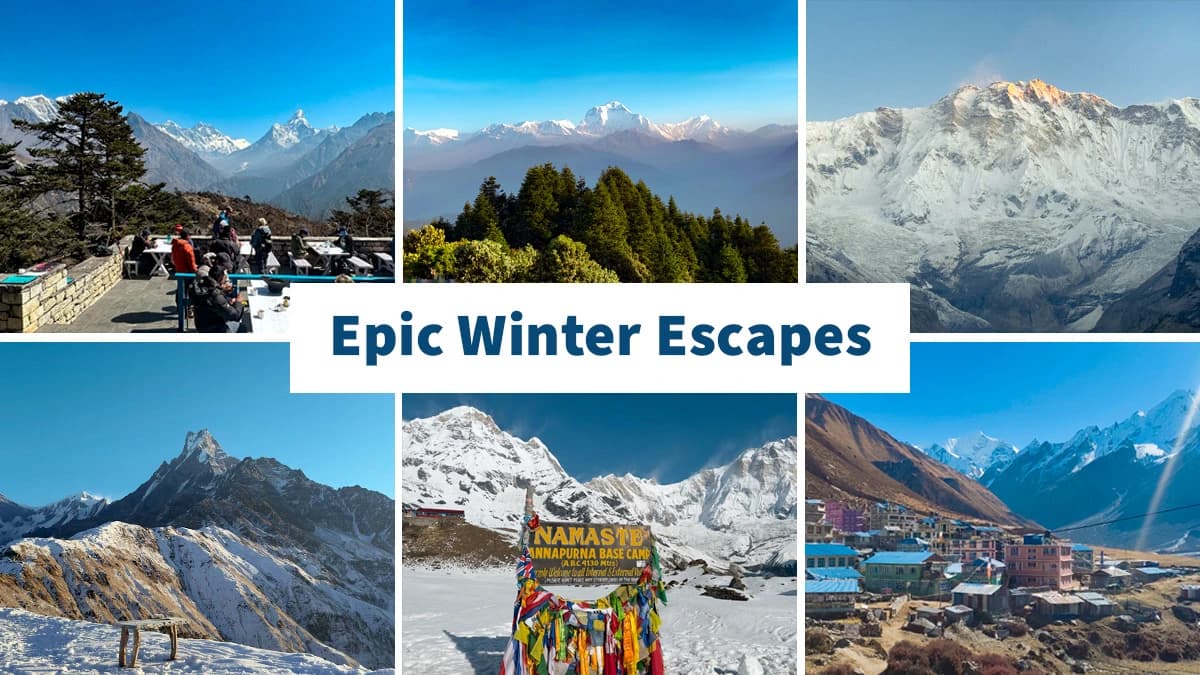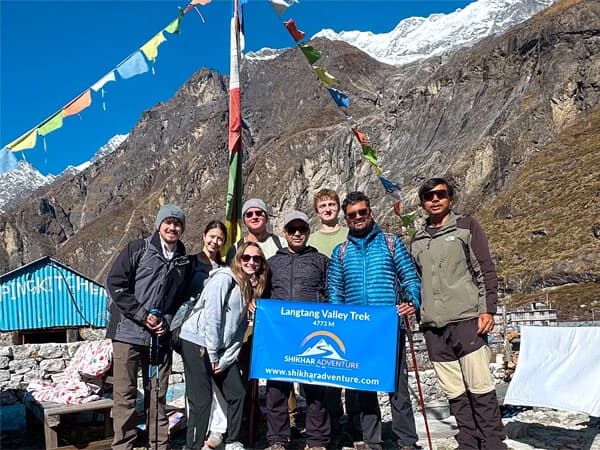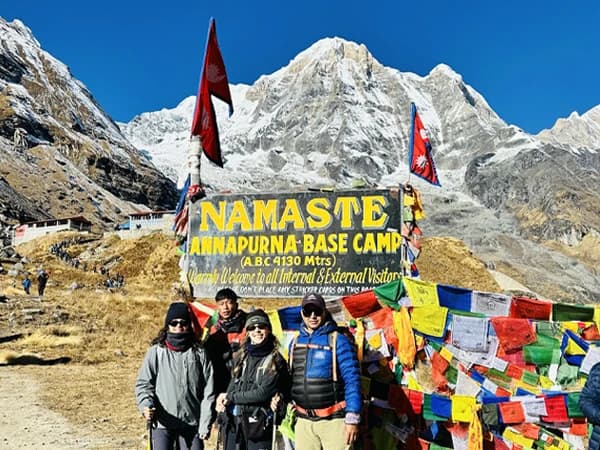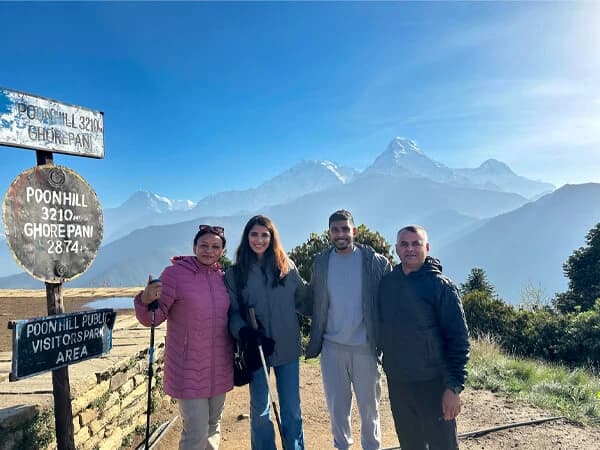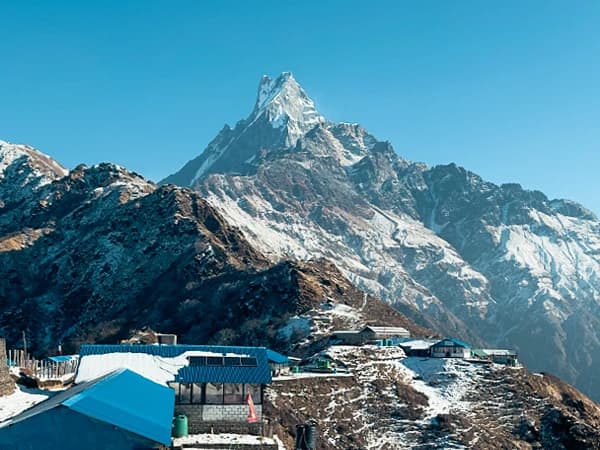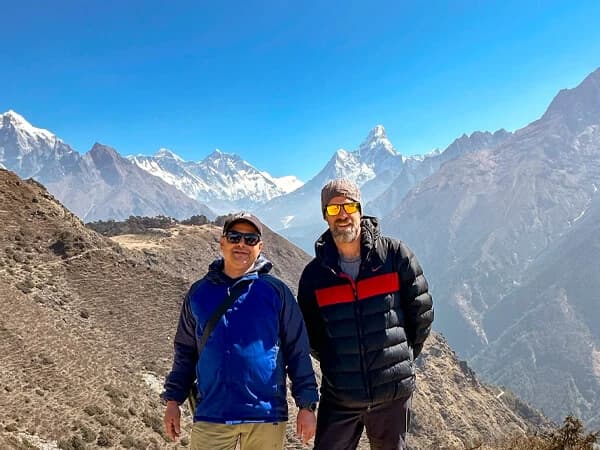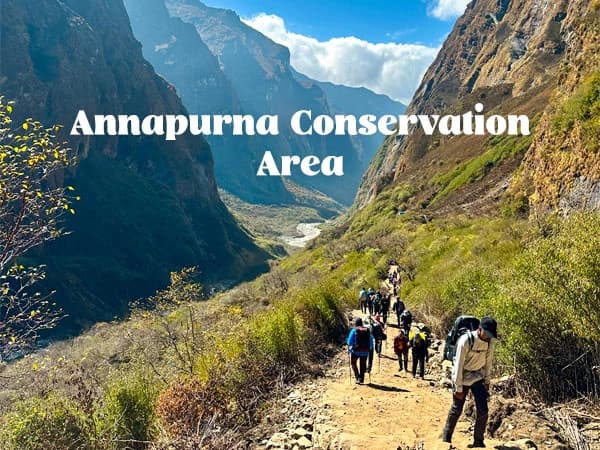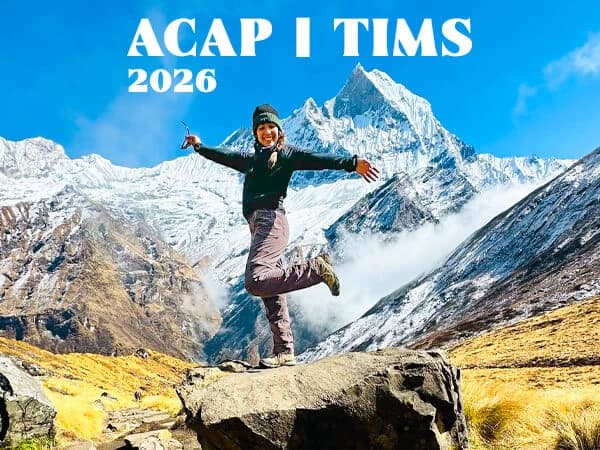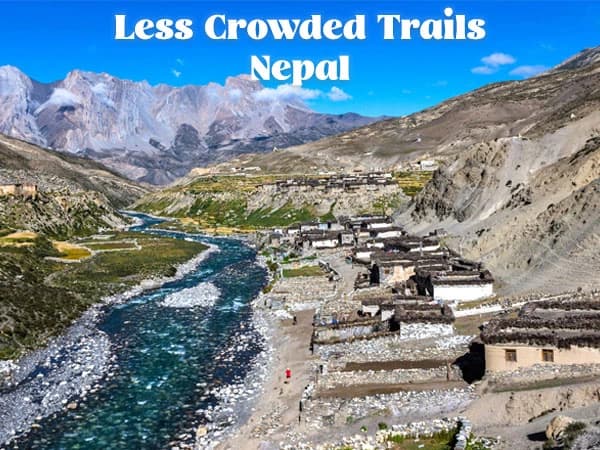Winter trekking in Nepal is a completely different experience, as one gets to hike less crowded, along breathtaking, snow-covered views. Being a guide for over 25 years, it is not unknown that the following trails, including Everest View Trek and Annapurna Base Camp, have extra charm in their views during the off-season. We will discuss all the basic tips and highlights to help you enjoy your winter adventure in safety. Don't get left behind; book your spot now for an amazing experience in the Himalayas!
Winter Treks in Nepal: A Complete Guide to Off-Season Himalayan Adventures
Winter trekking in Nepal is for those few braves that find beauty in cold and a thrilling factor in it, having the panorama of peaks around, which hardly anyone gets to see in their pristine silence.
Winter is one season in which not many tourists think about going on the famous treks of Nepal, but it has its own magic for those who bear the cold. The forest of snow and gigantic peaks are altogether a different experience.
Quieter paths beckon to avid trekkers and bold beginners alike. Winter season trekking in Nepal provides an opportunity to feel the most serene and undisturbed Himalayas.
In this guide, we will explore the best winter treks in Nepal. We’ll cover everything you need to plan your own Himalayan adventure.
Why Choose Winter for Your Himalayan Trek?
In Nepal, spring-from March to May-and autumn-from September to November-are two of the best trekking seasons. That is because during these months, the weather is generally mild, the sky is clear, and trekkers throng the trails. Winter extends from December to February, with cold weather and probable snowfall at higher altitudes. But for many people, its challenges make winter all the more alluring.
- Fewer Crowds: This is a major charm of winter trekking. The trails in the Annapurna and Everest regions get jammed with trekkers during the peak season; however, they are quiet during the winter. Free to enjoy peaceful moments and breathtaking views without any crowds.
- Unique Landscapes: Snow changes the look and feel of the Himalayas. Pine forests with a hint of white, partially frozen rivers, and villages that may remind one of a fairy tale of a winter wonderland-the icy rivers, trees with frost, and crisp mountain air give a complete different feel to this journey.
- Off-season Deals: Teahouses offer cheaper prices, flights to and from the trekking areas offer cheap flights, and some permits or guiding services may offer a discount.
- Photography Opportunities: Generally, winter offers crystal-clear skies with low humidity that may be suitable for shooting the white peaks against brilliant blue skies. Shooting of 'sunrise' and 'sunset' from those Himalayan giants, like Everest or Annapurna, is quite remarkable during the winter season.
Top Winter Treks in Nepal
Let’s dive into the top treks that offer a balance of accessibility, scenic beauty, and winter charm. Here’s a breakdown of each, including tips for navigating winter conditions and highlights that make these trails a winter paradise.
Everest View Trek

- Duration: 6-8 days
- Elevation: Max elevation ~3,880 meters (Everest View Point)
- Highlights: Panoramic views of Everest and Lhotse, Sherpa villages, Tengboche Monastery
The Everest View Trek is a short trek route within the Everest region. Actually, this would be the best option to see Mt. Everest for those not willing to invest in time or take in the altitude demands of an entire Everest Base Camp trek. Besides, winter enhances its generally striking landscape even more.
Your flight from Kathmandu to Lukla begins the journey, then a soft hike through picturesque Sherpa villages, tranquil pine forests, and scenic viewpoints affording stunning views of some of the highest peaks in the world.
- Tengboche Monastery: Actually, this is the spiritual heart of the Everest region. This monastery gets all the more enchanting during winter with every bit of snow in the surroundings and Mt. Ama Dablam as its background.
- Namche Bazaar: The largest town in the area, Namche is some sort of cultural hub. That place has lodges, bakeries, and local shops. It is less crowded during winters and very personal, hence giving a rich experience of Sherpa culture.
Winter Tips:
- Prepare for snowy trails and icy patches, especially near Namche.
- Take time to acclimatize at Namche, even on shorter treks, to avoid altitude sickness.
- Warm up with hot tea and enjoy traditional Sherpa dishes at the teahouses for extra comfort.
Poonhill Trek

- Duration: 4-5 days
- Elevation: Max elevation ~3,210 meters (Poon Hill)
- Highlights: Sunrise over Annapurna and Dhaulagiri ranges, dense rhododendron forests, Gurung culture
Ghorepani Poon Hill Trek is an excellent winter trek combined with all the sights of nature and cultural encounters. The altitude is pretty low, and it should be about the right height for beginners, offering one of the best sunrise views over the Himalayas. Winter is a fresh-snow time in the landscape that contrasts dramatically while the sun rises over the Annapurna and Dhaulagiri ranges.
- Poon Hill Sunrise: Trekkers get up early in order to behold the viewpoint for its smoldering view of the sun casting its first light on the snow-capped peaks. Winter skies are usually clear; hence, this is a striking view that gives more reason to travel.
- Gurung Villages: You will be able to pass by the ethnic Gurung villages along the trails and get to experience the real Nepalese hospitality. Winter seasons are much quieter, thus offering much more cultural exposure.
Tips for Winter:
- Although this is a low-altitude trek, bring warm clothing since the temperature mostly drops during the early hours of the morning.
- Most of the lodges are open during winter, but sleeping bag is necessary to be prepared for cold nights.
- Get up early and enjoy the sunrise with less crowd for great morning skies.
Annapurna Base Camp Trek

- Duration: 7-12 days
- Elevation: Max elevation ~4,130 meters (Annapurna Base Camp)
- Highlights: Annapurna Sanctuary, views of Annapurna I and Machapuchare, glaciers
For those seeking a moderate to hard winter trek, ABC Trek offers an adventure right in the middle of the Himalayas. It is a time during which one enters the wonderland of the Sanctuary: very few trekkers disturb your trail, and above the snow-covered landscapes is a breathtaking panoramic view of towering peaks.
- Annapurna Sanctuary: An area circled around, having a ring of mountains in amphitheater fashion. During winter, the scale and remoteness are near extreme when the snowfall mutes any sound apart from adding to the stillness.
- Machhapuchhare Base Camp: This is another beautiful viewpoint that trekkers reach before heading to Annapurna Base Camp. Locals consider Machhapuchhare, "Fishtail", a sacrosanct entity; hence, the magic of the trek to this place.
Tips for winter:
- Be prepared for freezing nights anytime, particularly up higher. Use a high-class, below-freezing-rated sleeping bag.
- Some parts of the trail can be covered in snow, so trekking poles and crampons provide additional stability.
- Fewer teahouses are open during the winter months. Either plan your accommodation well, or go with a guide who knows what is open and what is not.
Langtang Valley Trek
- Duration: 7-9 days
- Elevation: Max elevation ~3,870 meters (Kyanjin Gompa)
- Highlights: Langtang National Park, Kyanjin Gompa, traditional Tamang villages
The Langtang Valley, which is also called the "valley of glaciers," presents an opportunity for trekking through an immersion into Tibetan-influenced culture. Relatively close to Kathmandu, this makes for one of the best winter treks around due to its passage through considerably lower altitudes than other routes, yet still offers a wide mountain vista and cultural exposure.
- Kyanjin Gompa: Attached to the heart of Langtang Valley, this ancient Buddhist monastery is the central point of the trek. Winter scenarios recreate an ethereal charm of this place with snow-covered stupas and fluttering prayer flags amidst icy breezing.
- Tamang Villages: Tamangs are considered the indigenous people of this Langtang region. Winter treks allow for better interaction with the locals because not too many tourists actually trek in winter, making it culturally enriched.
Winter Tips:
- Because this area is relatively accessible, most winter treks in the area are possible with less snow; be prepared for cool nights, though.
- Teahouses still operate along much of this route, but since fewer trekkers come through, it's often best to confirm your lodging in advance.
- Bring microspikes or crampons for the icy parts near Kyanjin Gompa.
Mardi Himal Trek

- Duration: 5-7 days
- Elevation: Max elevation ~4,500 meters (Mardi Himal Base Camp)
- Highlights: Annapurna South and Machapuchare views, diverse terrain, remote feel
The Mardi Himal Trek is one of Nepal’s hidden gems and remains relatively undiscovered even in the peak seasons. Winter adds a beautiful touch of snow to the hills and ridges, making this trek ideal for those looking for a quieter experience with a blend of dramatic scenery and serene landscapes.
- High Camp and Mardi Himal Base Camp: Full views of Annapurna South and Machapuchare are there with snow underfoot in ridges, adding to the feeling of remoteness.
- It's a mixed terrain, right from the dense forests on the lower altitude range to the rough and snow-dusted alpine. The contrast is even more heightened during winters, and every climb a bit tougher.
Tips for Winter:
- Winter conditions make the ridge trail icy, and trekking poles along with a pair of sturdy boots with effective grip are recommended.
- High Camp requires warm clothes because the temperature vastly drops.
- Winter accommodation is rare; plan ahead, make reservations early, and/or ask locals which teahouses are open.
Essential Tips for Winter Trekking
- Dress Warm: plenty of layers, down jacket, insulated gloves, and thermal socks; waterproof insulated hiking boots with lugs for good grip take care of snow and ice.
- Safety First: Ascendations should be done at a slow rate, allowing more time for acclimatization for body adaptation to avoid altitude sickness. In winter, avoid such hazards as frostbites and avalanches because of steep terrain.
- Travel Insurance: Your insurance should cover trekking and high-altitude helicopter rescue; winter conditions can suddenly give way to an emergency on the trail.
Planning Your Trip
- Permits: The permits for places like the Annapurna or Everest region should be issued in advance. These permits monitor trekkers, which, in fact is a great concern in winters.
- Guides and Porters: Using local guides or porters, they know the trails in winter and will help with route finding on snow-covered trails, along with carrying extra gear.
- Weather and Timing: The winter season gives good views only in the months of December and January. February is also quite pleasant; however, the days are a bit warm due to the receding winter.
- Accommodations: Teahouses are mostly open, but services provided may not match the other peak seasons. Wear a warm sleeping bag and find out about the opening of lodges through guides or locals.
Savor the Adventure of a Himalayan Winter
Winter trekking in Nepal combines adventure, solitude, and the nation's natural beauty in a very special way. That's what makes this experience so highly rewarding and challenging. The Himalayas, inviting in winter with preparation, offer an adventure that few have ever taken on. Welcome the season, bundle up, and prepare to head out for an unforgettable journey among the world's highest peaks.
Being a trekking guide for more than 25 years and owning a trekking and tour company, I have been privileged in leading thousands of groups through Nepal's mountains in all seasons. I personally love winter trekking for the special challenges it puts forth and the pristine beauty it portrays. Let me allow a peep into some of my personal experiences that may help in telling how you can make the most of a winter trek in Nepal:
Insights from an Experienced Trekking Guide
Safety and Acclimatization Are Key
Winter trekking needs extra caution. The cold accentuates the effect that altitude has on the body, and I always recommend slower ascents, paying attention to being hydrated. Sometimes this rest day in Namche Bazaar or Ghorepani-in fact, on sometimes even shorter treks-makes a difference. Symptoms of high altitude can come anytime during winter; it just depends on watching them.
Choosing an Appropriate Trail
Not all treks are suitable in winter. I’ve seen trekkers attempt high passes like Thorong La in Annapurna Circuit or Cho La in Everest, only to turn back due to snow. The best trails for winter are moderate-altitude routes that don’t require high passes, like Langtang Valley or Mardi Himal, which are well suited to winter’s challenges.
Local Guides and Porters must be hired.
The local guides really know the condition of the winter and are trained for sudden changes in weather or trail closures. We also know the safest places to cross certain sections or how to avoid icy spots. In addition to making your trek a lot safer, it is a great way to support the local economy by hiring a guide or porter locally, especially during the off-season when fewer travelers come through.
Packing Wisely for Cold Conditions
Likewise, I have watched many trekkers over the years totally underestimate the cold which can set in at altitude, even on easy treks like Poon Hill. This is why I will always recommend that our clients invest in good winter gear: a good down jacket, insulated boots, and a good sleeping bag rated below-freezing. This is about being prepared for conditions harsher than expected.
Conclusion
Winter trekking in Nepal is not at all about being physical; it is all about connectivity-to nature, to the self, and with the communities one crosses. You will find all the local tea houses far more welcoming with fewer people, hence better opportunities to learn about Sherpa, Gurung, or Tamang traditions. Being a guide myself, I always make it a point that my clients have time for such quiet interactions, which mostly get missed during the busy season of trekking.
More than that, by understanding winter trekking through one of the best guides, one will be well-equipped to take on the Himalayas in this remarkable season. Nature in winter is starkly beautiful, and the key to any successful trek is preparation. This is my advice: take up the challenge, respect the mountains, and you will have an adventure that shall stay with you for all your lifetime.
Winter trekking in Nepal offers an unbeatable mixture of serenity, adventure, and breathtaking landscapes. Let me take you into the venture for a different encounter of the Himalayas, should one be ready. With the backing of this committed team, besides a vastness of experience myself, we ensure that your adventure here in the Himalayas is safe and memorable and a lifetime-changing affair.
Book a place on one of our winter treks and experience the unparalleled landscapes of Nepal at their most unsullied. Off-season trekking goes to quiet beauty and gives it its due.



